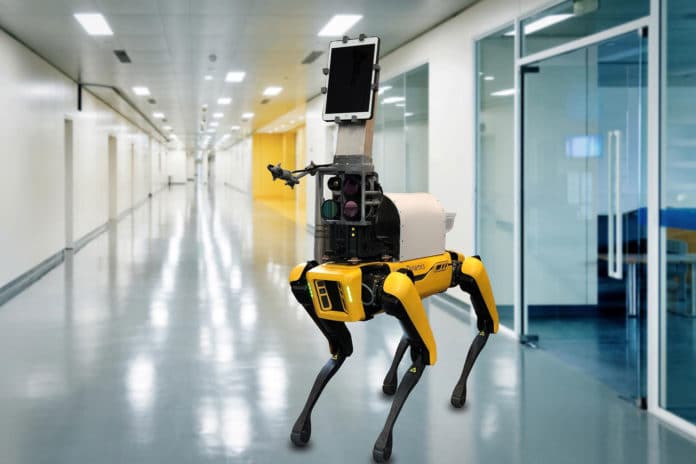The robotic dog Spot, manufactured by Boston Dynamics, has been available for purchase since September 2019. As much as the invention has become an instantaneous phenomenon on the internet, many still wondered what would be the real practical utility for the technological quadruped that costs $74,500. Well, the Massachusetts Institute of Technology (MIT) seems to have a good answer to these questions.
Researchers from MIT and Brigham and Women’s Hospital intend to test the use of the Spot robot to monitor vital signs of potentially infectious patients, allowing healthcare workers to minimize their exposure to the novel Coronavirus. Using existing computer vision technologies, Dr. Spot is capable of measuring skin temperature, breathing rate, pulse rate, and blood oxygen saturation in healthy patients, from a distance of 2 meters.
Controlled by the handheld device, Dr. Spot also carries a tablet that allows doctors to ask patients about their symptoms without being in the same room. The researchers mounted four different cameras onto the robot, including an infrared camera and three monochromes cameras that filter out different wavelengths of light.
In addition, they developed algorithms that allow them to use the infrared camera to measure both elevated skin temperature and respiratory rate. For body temperature, the camera measures that of the skin on the face, and the algorithm correlates it with core body temperature. It also takes into account the ambient temperature and the distance between the camera and the patient, so that measurements can be taken from different distances, under different weather conditions, and still be accurate.
Infrared camera measurements can also be used to calculate patient’s breathing rate. As the patient inhales and exhales with a mask, their breath changes the temperature of the mask. Measuring this change in temperature allows you to calculate how fast the patient is breathing.
The three other cameras filter a different wavelength of light of 670, 810, and 880 nanometers. These lengths make it possible to measure the slight color changes that result when hemoglobin in blood cells binds to oxygen and flows through the blood vessels. In this way, they can calculate both the pulse rate and oxygen saturation in the blood.
“We didn’t really develop new technology to do the measurements,” says Henwei Huang, one of the lead authors of the study. “What we did is integrate them together very specifically for the COVID application, to analyze different vital signs at the same time.”
The researchers performed the measurements on healthy volunteers and are now making plans to test the robotic approach in people with COVID-19 symptoms. For the project to be used on a large scale, however, approval from the Food and Drug Administration (FDA) is required.
The Spot robot has already been used to monitor social distancing during the lockdown period. Also, from inspecting construction sites, operating as a “shepherd dog” in New Zealand farms to working on oil rigs, a number of uses are being explored for this robot dog.
